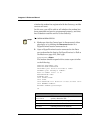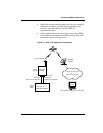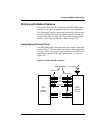
Integrator’s Reference Manual
5-4 80-99208-1 Rev. D
Packet/Asynchronous Data Overview
The GSP-1620 modem handles both packet and asynchronous
data connections. For a particular SCADA application, one
may make more sense than the other. Table 5-1 compares the
two types of data.
Tip
QUALCOMM Globalstar packet data service has a lower overhead and
faster connection time than asynchronous data does. In general, if a
SCADA application does not specifically need asynchronous data, use
packet data instead.
For more details about implementation issues specific to one
type of data or the other, see Using Packet Data on page 5-21
and Using Asynchronous Data on page 5-30.
Table 5-1. Packet vs. Asynchronous Data
Packet Data Asynchronous Data
Connects through a
Globalstar Gateway to the
Internet.
Connects through a Globalstar
Gateway and the PSTN to a
remote host modem.
Packet data is transmitted
over the Internet to a host
server.
Asynchronous data is
transmitted to a dial-up modem
or modem bank, which must be
supplied by the host.
Typically establishes
connection within 2-3 seconds.
Typically establishes connection
in approximately 30-60 seconds,
due to modem negotiation and
training time.
No long distance charges
apply, because a connection is
made directly to the Internet.
PSTN long distance charges
may apply.
Degradation of service (in the
transmission of packets) could
occur, depending on Internet
connections and routing.
Degradation of service could
occur, depending on the quality
of lines over the PSTN. (A noisy
PSTN line can lower the data
transmission rate or introduce
errors into the data stream.)


















